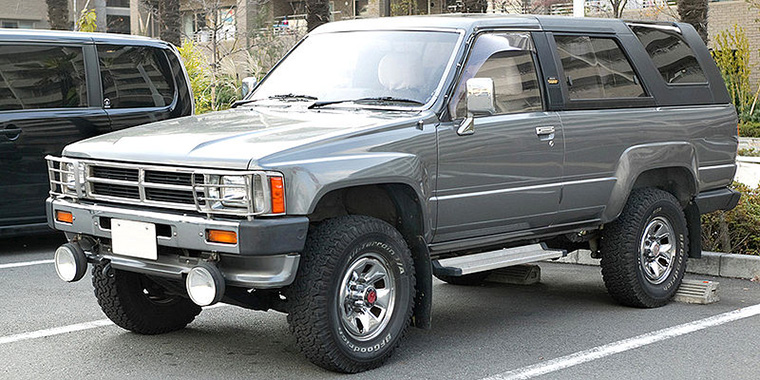

Toyota Hilux Surf
The Toyota Hilux Surf (豊田 ハイラックスサーフ Toyoda Hairakkususāfu) is an off-road vehicle manufactured by Toyota, sold mainly in Japan, with large numbers exported as used vehicles to Somalia, Pakistan, Afghanistan, United Kingdom, Ireland, New Zealand, and Australia. The original Surf was little more than a Toyota Hilux pickup truck with a fiberglass shell over the bed, but the model has since undergone significant independent development into a mid-size, off-road vehicle. The first and second generations were derived from the Hilux Pick-Up range, while the third and fourth generations were effectively rebodied Landcruiser Prados.
The Hilux Surf is sold outside Japan, primarily in the United States and Australia, as the Toyota 4Runner. The second generation models were also briefly marketed in the United Kingdom as the Toyota 4Runner. The first run of Hilux Surf models were built at Toyota's plant in Tahara, Japan, but starting with the third generation models, production was split between the Tahara plant and Hino Motors' Hamura, Japan plant. For South-east Asia the Hilux Surf was replaced in 2005 by the similar Fortuner, which is based on the Hilux platform.
Toyota (Winnebago) Trekker (1981-1984)
The Toyota Trekker was one of the first prototype walk through conversions done to Toyota trucks in the early 1980s. They were similar to the successive 4runner conversions done by Toyota, which started production in 1984, but were designed and built by Winnebago with the approval of Toyota.
The Toyota Trekker was produced from early 1981 through 1983. The Trekkers were all pickup trucks, classified as SR5 or deluxe models originally by VIN number, but were all classified SR5 after assembly. Toyota shipped all trucks from Japan as cab and chassis only to get past the 25% truck import tax in the USA. While many trucks went on to have a bed installed on them in the USA, some went to Winnebago for the Trekker kit installation. The Trekker conversion consisted of a fiberglass tub, bed sides, (non removable) canopy and rear hatch. The kit included a folding rear seat that could lay flat to add cargo space to the back. A few of the Trekker conversion kits were sent to Canada and Saudi Arabia to be installed at their destination by the selling dealer. The Trekkers were no longer a viable conversion when Toyota started producing the 4Runner in 1984.
First generation (1984–1989)
Instead of developing an entirely new model, Toyota took the existing Hilux with short-bed pickup body, made some simple modifications, and added a removable fiberglass top to form the Hilux Surf. The implementation was borrowed from both the first generation Ford Bronco, and the Chevrolet K5 Blazer, both shortbed trucks with removable fiberglass shells over the rear sections and having bench seats installed in the back. Like the Bronco and the Blazer, the Hilux Surf also didn't have an integrated rear window attached to the front section of the roof over the front seats. In that sense, all three vehicles were not conventional pickup trucks with a fiberglass shell included.
Thus, the first generation Surf is nearly mechanically identical to the Toyota Hilux pickup. All first generation Surfs had two-doors and were indistinguishable from the pickups from the dashboard forward. Nearly all changes were to the latter half of the body; in fact, because the rear springs were actually downgraded with one leaf less than the pickup, with the additional weight of the rear seats and fiberglass top, these models tend to suffer from sagging rear suspensions (a problem which continued to afflict later generations of the Surf). The first Surfs were introduced in 1984 (known as the 1984½ model year in America). For this first year, all models were equipped with black or white fiberglass tops.
In 1986, the Surf underwent a major front suspension design change as it was changed from a solid front axle to the Hi-Trac independent front suspension. This change made the Surf more drivable at highway speeds and increased the space in the engine compartment (necessary to fit larger engines, such as the V6 introduced in 1988) but arguably decreased the truck's off-road capabilities. The Hilux at this point retained the more rugged and capable, if less refined, solid axle configuration
Small cosmetic and option changes were made in 1989, but the model was left largely untouched in lieu of the replacement model then undergoing final development.
Second generation (1989–1995)
For 1989 (MY 1990) the Surf continued its reliance on the Hilux pickup - as the pickup was redesigned, the surf followed. It remained virtually identical to the Hilux from the 'B' pillars forward, but this time gained a full steel integrated body in place of the prior fiberglass cap. It also gained an all new coil sprung rear suspension system, which unfortunately proved to be just as prone to sagging as the leaf springs on the rear of the previous models.
Nearly all second generation Surfs are 5-door models, however from 1990 to 1992, a 3-door model was also produced. These vehicles are somewhat rare and were discontinued in August 1992.
It was available with a range of diesel engines, including a 2.4 L turbodiesel I4 up to 1993, followed by a 3.0 L turbodiesel I4. Small numbers were also made with a normally aspirated 2.8 L diesels and 2.0 and 2.4 L I4 naturally aspirated petrol engines.[1] The majority of petrol versions received the 3.0 L V6.
Most other full-body Off-road vehicles produced at the time featured tailgates that opened upward with the glass closed. In contrast, the second generation Surf carried over the retractable-glass tailgate from the first generation. Opening these tailgates requires first retracting the rear window into the tailgate and then lowering the tailgate, much like as on a pickup truck.
In 1992, the Surf received minor cosmetic updates, including larger 'Aero' headlamps and one-piece front bumpers. At this time a Wide body version was introduced featuring extended wheel arch flares along with wider wheels and tyres. This facelift distanced them somewhat from the Hilux pickups which did not receive the same cosmetic changes. Various trim levels were offered ranging from the base model 'SSR' through 'SSR Ltd', 'SSR-V' 'SSR-X' and 'SSR-X Ltd' to the range topping 'SSR-G'.
A commonly noted weakness on the 2.4 turbodiesel engine is a tendency to crack the cylinder head. Any episode of overheating may result in internal cracking of the head. Some were recalled in their domestic market and had the head replaced. The replacement "modified" head is the same head as fitted to the 2.8 normally aspirated diesel models. It is not possible to visually identify if a fitted head is of the modified type, as the only differences are in the wall thicknesses of certain internal waterways
Third generation (1995–2002)
For 1995 (MY 1996) the Surf got an all-new body shell on an all-new chassis. This time, it shared virtually nothing with the pickup it had originally evolved from, and had more in common with the Land Cruiser, as it shared its chassis with that of the LWB Land Cruiser Prado.
Significant changes from the second generation models include a larger body on a longer wheelbase, increased interior space, increased cargo space, twin airbags, coil sprung suspension front and rear, ABS brakes, lift-up tailgate, rack and pinion steering and 16 inch wheels. One of the biggest mechanical changes was the addition of a center differential, enabling the use of four wheel drive on hard surfaces without complication for the first time. The prior ADD system was also retained to give on-the-fly shifting between rear and four wheel drive as before.
Trim and model designations remain similar to those used for the second generation models.
The fourth generation Surf incorporated serious changes to the chassis and body of the vehicle but was targeted at approximately the same demographics as the third generation. The updated Surf looks very different from the older Surfs, but it was designed to the same criteria as a mid-size, quasi-luxury, off-road vehicle. It continues to share most of its underpinnings with the Land Cruiser Prado of similar age.
In 2009, Toyota Japan ceased production of the Hilux Surf.
Fifth generation (2009–present)
In October 2009 (MY 2010) Toyota USA launched the fifth generation 4Runner. No Hilux Surf counterpart was listed for the Toyota Japan lineup.








